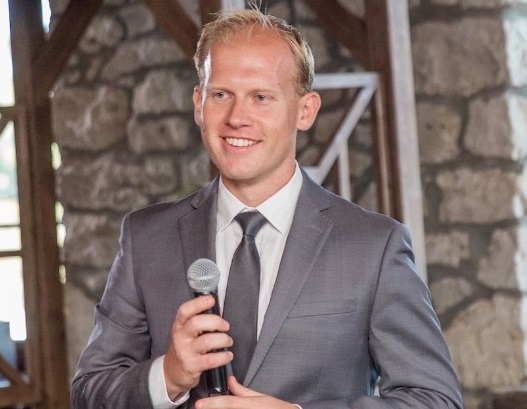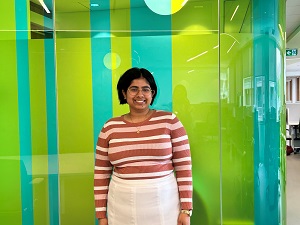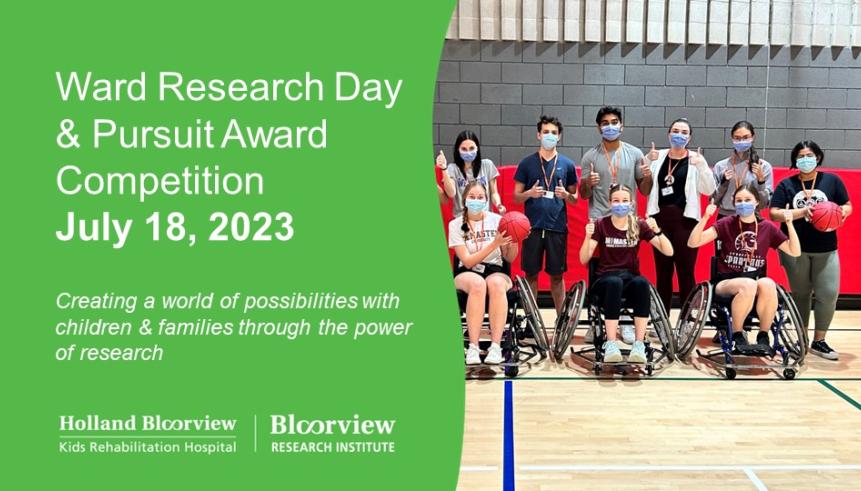
2023 Ward Research Day and Pursuit Award Competition
Each summer, the Ward Family Summer Student Research Program attracts students from universities from all over Canada to collaborate alongside some of the brightest minds in childhood disability and developmental differences research in the world.
These budding young scientists are embedded in Bloorview Research Institute's research labs such as the Autism Research Centre, the CP Discovery Lab, the Neuromodulation Lab and the PRISM Lab to help researchers unlock a world of possibilities for children and youth with disabilities.
This year we have 16 of the best and brightest undergraduate students who were selected for this prestigious program from over 1,800 applications coast to coast.
The final highlight of the program is the opportunity for these talented students to highlight their research at the annual Ward Research Day and compete for the best research poster and best oral presentation.
In addition, the annual Pursuit Award competition attracts some of Canada’s and the world’s top young minds to showcase their impactful research in pediatric disability and developmental differences.
For the first time, the Bloorview Research Institute brought together both students and Pursuit Award finalists to shine a bright light on how the power of research can transform the lives of children and young people living with disabilities and developmental differences.
This year’s inaugural Ward Research Day and Pursuit Award Competition was held in Holland Bloorview's Coriat Atrium and live streamed over Zoom Webinar on Tuesday, July 18, 2023, 9 a.m. to 12:30 p.m. EST
This year's winner in the Best Research Poster category is Kansas MacKay, McMaster University Mechanical & Biomedical Engineering Co-op program
The winner in the Best Oral Presentation category is Simran Joneja, Queen’s University, Honours Bachelor of Health Sciences program.
Congratulations to all of the Ward summer students!
The Ward Family Summer Student Research Program and the annual Pursuit Awards are made possible through The Ward Family Foundation, Holland Bloorview Foundation donors and the Bloorview Research Institute. The Lived Experience and Indigenous Streams within the program are generously supported by CIBC.

| 9 a.m. | Welcome Remarks |
| 9:15 a.m. | Keynote & Q & A: Patrick Jachyra, assistant professor, University of Durham, United Kingdom |
| 9:45 a.m. | Quick Hit Presentations & Kahoot Quiz with Ward students |
| 10:40 a.m. | SHORT BREAK |
| 10:45 a.m. | Pursuit Award finalist presentations |
| 11:15 a.m. | Student poster sessions (in-person at Bloorview Research Institute's High Performance Hub on 5th floor and virtual over Zoom) |
| 12:00 p.m. | Awards Ceremony |
| 12:20 p.m. | Closing Remarks |
| 12:30 p.m. | Event wraps |
Keynote: Patrick Jachyra, Assistant Professor, Durham University
Supporting the physical activity and rehabilitation of children and youth with autism: Lessons Learned and Future Directions
This keynote will outline research centred on supporting the physical activity and rehabilitation of children and youth with neurodevelopmental differences, drawing on research from Canada and the UK.
Throughout the presentation, lessons learned through the journey of being an early career researcher will be shared. The presentation concludes by outlining future directions, anticipated challenges and opportunities to make the world more inclusive for children and youth with neurodevelopmental differences.
Biography:
Dr. Patrick Jachyra is an Assistant Professor at Durham University in the United Kingdom and an Affiliate Scientist at the Centre for Addiction and Mental Health in Toronto. Dr. Jachyra’s research seeks to understand how to optimally support the physical activity participation, well-being and thriving of children and youth with neurodevelopmental differences, with a focus on autism.
Watch his keynote speech here.
We are thrilled to announce this year's top recipients for the 2023 Pursuit Award competition:
- 1st Place: Jennifer Ryan, physiotherapist, Holland Bloorview Kids Rehabilitation Hospital and postdoctoral fellow at the SickKids Research Institute, Toronto, Canada
- 2nd Place: Caroline Elfassy, PhD candidate, McGill University, School of Physical and Occupational Therapy, Montreal, Canada
- 3rd Place: Manjula Manikandan, postdoctoral researcher, Royal College of Surgeons in Ireland University of Medicine and Health Sciences, Dublin, Ireland
Learn more about the 2023 Pursuit Award recipients.
Ward Student Profiles and Research Posters
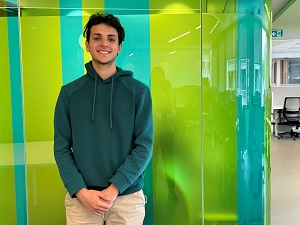
University and Program: University of Toronto - Engineering Science - Biomedical Engineering Option
Supervisor and Lab: Dr Tom Chau, PRISM Lab
Project Title: Designing a software library to enhance the development of brain-computer interface data processing pipelines.
Principal Investigator: Tom Chau
Research Summary:
Brain-Computer Interfaces (BCI) are communication technologies that allow users with disabilities and complex communication needs to communicate using only neural activity. BCIs use computational algorithms to analyze brain signals and recognize specific user thoughts. While processing algorithms are ubiquitous throughout BCI research, few platforms exist for rapid pipeline prototyping and implementation. Consequently, the significant technical competencies and resource investment are barriers that can impede researchers. While design tools aimed at reducing these barriers exist, they can be hard to use, or difficult to customize, and lack standardized code, limiting opportunities for collaboration throughout BCI research. Thus, this project's goal is to build a highly customizable, standardized BCI-software development tool that standardizes code and does not require extensive technical competencies.
Research Question: How can a software design tool reduce technical barriers to brain-computer interface design and development?
Methods & Analyses: The tool is a Python-based software library that leverages various data science libraries for mathematical computation.
Results: The developed program, BCIPY, allows designers to allocate more time to experimenting with novel pipelines instead of concentrating on the code behind a particular BCI. The library can be seamlessly integrated into existing visual interfaces to expand application capabilities.
Conclusions: BCIPY enables the development of BCIs with minimal programming expertise. Consequently, the tool aims to foster research into applications of BCI and expand their clinical usability.
Relevance to Holland Bloorview: This software is especially relevant in the context of pediatric care research. Through BCIPY, designers can more easily develop alternative communication pathways for pediatric clients with communication challenges. Furthermore, the tool provides an opportunity for individuals without extensive programming experience (ie. clinicians, scientists) to actively engage in BCI development and research.
Bio:
Aaron is a third-year student at the University of Toronto, pursuing a BASc in Engineering Science with a major in Biomedical Engineering. He is deeply interested in exploring the application of innovative technologies to enhance social welfare, specifically in the context of healthcare accessibility and patient outcomes. In his second summer as a Ward Summer Student, Aaron is continuing his work alongside PhD candidate Nicolas Ivanov in the PRISM Lab, led by Dr Tom Chau, to develop an open-source software library to assist with data processing pipeline prototyping and development. His project has allowed him to develop a better understanding of the clinical applications of BCI, machine learning in healthcare, biological signal processing, and object-oriented programming. Aaron has previously contributed to research involving Focused Ultrasound, a multi-functional non-invasive surgical technology with the ability to target deep tissue without incisions or radiation. Aaron has deeply appreciated the immersive and invaluable learning opportunities presented to him through his work in the PRISM Lab.
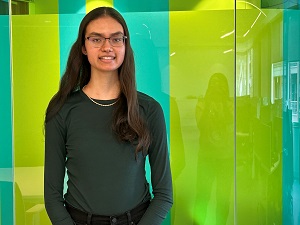
University and Program: McMaster University – Integrated Biomedical Engineering and Health Sciences
Supervisor and Lab: Dr. Tom Chau, PRISM Lab
Project Title: Gaze Optimized Augmented Reality Keyboard Application for Children and Adults with Severe Motor Impairments
Principal Investigators: Dr. Tom Chau, Mahya Mirbagheri
Research Summary:
Background/Rationale: Although using a computer and searching the internet is an integral part of everyday life, there are few opportunities for those with severe motor impairments and complex communication needs to independently participate in these activities. The Hololens2 is a mixed reality headset that uses eye tracking to enable users to interact with their environment. The goal of this project is to create an accessible, user friendly, augmented reality interface to allow more individuals with disabilities to access information through a question/answer system that resembles the functionality of the internet.
Research Question: Can a user friendly, gaze optimized AR keyboard accelerate typing performance and speed?
Methods/Analyses: The graphical interface, developed with Unity 3D and C# programming, consists of multiple features that promote ease of use while typing. The alphabetical keyboard is organized in a
circular arrangement, with commonly used letters on the inner ring of the keyboard. Each key is accompanied by a circular timer that tells the user how long they have left to select a particular
letter or sentence with their gaze. A User History and Common Questions panel were incorporated to allow users to select questions or previously typed queries. A Search Results panel displays the answer to their query, which is generated using advanced natural language processing techniques. Other features of the interface include predicted word/sentence suggestions, a numerical keyboard, and an enter key.
Results: In pilot testing, a gaze-based typing speed of 36 words per minute was recorded. This is measurably faster than previously designed keyboards that average 17.35 wpm.
Conclusions/Next Steps: The new structure of the interface can enable individuals with severe motor impairments to quickly type queries and obtain answers. Next steps include obtaining user feedback about the functionality of the interface and conducting a study to measure typing speed.
Relevance to Holland Bloorview Clients Families: This gaze-based keyboard will be used in rehabilitation sessions, allowing children and adults with severe motor impairments to experience independence while asking factual questions and receiving answers.
Bio:
Anusha is entering her fifth year of the Integrated Biomedical Engineering and Health Sciences program at McMaster University. She enjoys using her interdisciplinary knowledge in engineering and science to solve real-world problems in the health-care field. As a Ward Summer Research Student in the PRISM Lab, she is using Unity, a cross-platform game development software, to develop a user-friendly, gaze-optimized keyboard application for the Hololens2. This augmented-reality (AR) keyboard enables users with fine motor skill impairments and complex communication needs to type a question or statement by simply looking at alphabetical keys on the interface. Data scraping techniques are then used to provide an answer from the internet.
Anusha is an advocate for youth with disabilities as she wrote, illustrated, and published a children’s book called “Logan Learns to Play”, to raise awareness for diversity and inclusion in soccer. Anusha enjoys being involved in her community as a soccer coach and visual art instructor for youth with disabilities. She hopes to continue to use biomedical engineering to improve the lives of others.
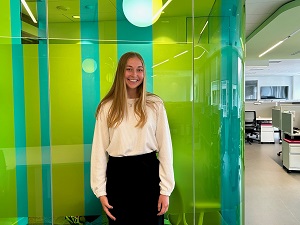
University and Program: McMaster University - Biomedical and Mechanical Engineering
Supervisor and Lab: Jan Andrysek - PROPEL Lab
Project Title: A Turn Detection Algorithm in a Wearable Gait Rehabilitation Application for Lower-Limb Prosthetic Users
Principal Investigator: Jan Andrysek
Research Summary:
Background: Lower-limb prosthetic users (LLPUs) have undergone lower-limb amputation and rely on prostheses for walking. Wearable sensors have been proposed as a supplementary tool to clinic-based gait rehabilitation, allowing LLPUs to correct their gait and improve symmetry between limbs outside of the clinic. However, the wearables require robust gait algorithms for real time recognition of a user’s activity (e.g., turning, stair ascent) to ensure that they are usable without clinical supervision and in uncontrolled community environments.
Research Question: Can a robust algorithm be created that correctly detects the start and end points of turns during gait?
Methods: A heuristic threshold-based algorithm was developed in Python that identifies turns from angular velocity peaks. Four able-bodied participants wore an inertial measurement unit on each ankle and tri-axial acceleration and angular velocity data was collected during straight-line walking and right/left turns at four different angles (90°, 120°, 150°, 180°). The data was passed into the algorithm and the algorithm’s ability to detect turns was assessed by determining the sensitivity along with the percentage of false positives and false negatives.
Results: Preliminary analyses indicate that the algorithm accurately detected turn start and end points with a high degree of sensitivity and minimal false positives/negatives.
Conclusions: While the algorithm successfully detected turns in able-bodied individuals, further testing should be conducted with LLPUs to validate its performance and applicability.
Relevance to Holland Bloorview Clients & Families: A wearable rehabilitation system may improve gait and walking symmetry for children and youth with lower-limb prosthetics outside of clinical settings, enhancing their mobility, independence, and long-term musculoskeletal health.
Bio:
Elise Schwarz is a fourth-year student in the Integrated Biomedical Engineering and Health Sciences program at McMaster University. With her specialty being Biomedical and Mechanical Engineering, Elise is passionate about using engineering to create medical devices that can help people and improve their quality of life.
Currently, Elise is working in the PROPEL (Pediatric Rehabilitation, Orthotics/Prosthetics, and Engineering Locomotion) lab under the guidance of Dr. Jan Andrysek. Her primary focus is on a rehabilitation device that allows lower-limb prosthetic users to monitor, improve, and train their gait outside of a clinical setting. In this role, Elise is responsible for designing algorithms for the accompanying app, collecting gait data from IMU sensors, and conducting rigorous testing.
Elise is honoured to be selected as a Ward student this year. She believes Holland Bloorview is a special place for children and their families and feels privileged to be involved in research. She is committed to understanding the unique challenges faced by children with disabilities and is passionate about contributing to their quality of care through innovative engineering solutions. She is excited to collaborate with researchers, gain invaluable hands-on experience, and contribute her knowledge, skills, and enthusiasm to advance research and make a tangible impact on the lives of children with disabilities.
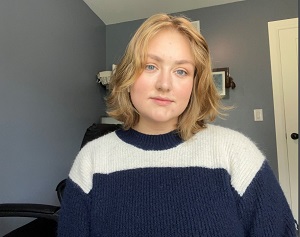
University and Program: Carleton University – Forensic Psychology
Supervisor and Lab: Dr. Danielle Baribeau, Autism Research Centre
Project Title: Longitudinal Predictors of Behavioral Crises in Children with Neurodevelopmental Disorders
Principal Investigator: Dr. Danielle Baribeau
Research Summary:
Background/rationale: Predictors of behavioral crises (e.g., emergency department visits or hospitalizations) in children with neurodevelopmental disorders (NDDs) are poorly understood.
Research Question: What biological, behavioral, environmental, and sociodemographic variables are associated with crisis outcomes in children with NDDs who are receiving medication management for behaviour or mental health concerns?
Methods and Analyses: We conducted a chart review using health record data from the Psychopharmacology clinic at Holland Bloorview. Our sample includes all patients seen between 01/01/2019 to 01/01/2022. Preliminary analyses were performed using a univariate cox proportional hazard model looking at rate of crisis with days since initial consult as the time scale.
Results/What are we learning? Charts from a total of 777 visits, across 88 unique patients, were reviewed so far. Each patient was seen for a mean of 7.3 (SD=5.3) visits over a mean of 38.5 months (SD=33.7). There were 50 new behavioural crises, experienced by 23 unique patients (26%) during follow-up. Preliminary analyses indicate that older age [Hazard ratio (HR): 1.2 (1.1 to 1.5)], history of traumatic experiences- [8% of patients, HR 10.5 (3.3 to 34.0)], prior crises [HR 6.1 (2.3 to 16.2)] and history of caregiver burnout- [17.0% of patients, HR 3.8 (1.5 to 9.5)] were predictive of behavioural crises, but not sex, family history of psychiatric disorder, IQ, or verbal communication abilities.
Conclusions/next steps: Research at this stage is preliminary but emphasizes that environmental and family experiences are important contributors to the risk of behavioural crises in NDDs. Next steps include expanding the sample (plan for 377 unique patients) and expanding to multivariable models.
Relevance to Holland Bloorview clients and families: These predictors can help clinicians and families anticipate support needs and direct resources to prevent behavioural crises in children with NDDs.
Bio:
Emma is an undergraduate student at Carleton University going into her third year of Honour’s Psychology with a specialization in Forensics and a minor in Criminal Justice. She is a Ward Summer Student in the Autism Research Centre with Dr. Baribeau. This summer they are conducting a chart review study from the Psychopharmacology clinic investigating crisis outcomes in children and adolescents with Autism Spectrum Disorder and Intellectual Disability. The data from this study will be used to analyze a variety of outcomes and provide insight into the experiences of individuals in this clinic. She is thankful for the opportunity to be involved in this research and excited to gain experience in this field.
As her studies continue, Emma aspires to continue being involved in research and is interested in studying law. This project has given her invaluable insight into the intersection of research and law outside of her studies. Her experience in Early Childhood Education and at Holland Bloorview has made her passionate about equitable and accessible resources for all children. In her free time, Emma spends her time with her dog Bella and enjoys boxing at the gym.
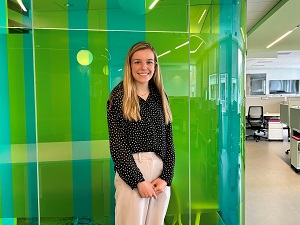
University and Program: McMaster University Mechanical & Biomedical Engineering Co-op
Supervisor and Lab: Dr. Jan Andrysek, PROPEL Lab
Project Title: Design and development of a diagnostic prosthetic system to enhance trans-radial prosthetic fabrication
Principal Investigator: Jan Andrysek
Research Summary:
Background: Trans-radial prostheses aim to replicate the form and function of the arm and hand to assist with daily activities. Fabrication of these devices requires trial-and-error on the part of the clinician, which can result in more appointments for a client, and a less than optimal final prosthesis. Clinicians have indicated the need for an adjustable ‘diagnostic’ prosthesis that can be used to assess aspects such as fit and function, prior to the fabrication of the final definitive prosthesis.
Objective: Develop and evaluate a diagnostic prosthetic system that enables quantifiable alignment adjustments and simulates the weight and function of a trans-radial prosthesis.
Methods: Using Computer-Aided Design software, 12 full-assemblies were generated in-line with target specifications developed as part of co-creation with clinicians and clients. Prototype iterations were 3D printed to evaluate the suitability of various joint mechanisms, component sizes, and materials by performing structural integrity tests. The design was presented to clinicians for feedback and once approved, presented to a manufacturer for fabrication.
Results: Pilot testing of the prototype’s third iteration demonstrated that joint mechanisms, alignment quantification, and universal design considerations met target specifications.
Conclusions: Once the adjustable forearm device is manufactured, further structural testing will be performed followed by clinical testing to assess functionality in practice.
Relevance to Holland Bloorview Clients & Families: The Holland Bloorview Orthotics & Prosthetics clinic hosts approximately 4500 client visits per year; many of those clients are pediatric patients looking to be quickly fit for an upper-limb prosthesis to meet growing needs.
Bio:
Kansas Mackay is a fourth-year Mechanical and Biomedical Engineering student at McMaster University working with the PROPEL Lab and Dr. Jan Andrysek as a WARD Summer Research Student. Her ongoing research involves designing and fabricating an updated version of an adjustable diagnostic forearm (ADF), a trans-radial prosthetic device that enables prosthetists to make live adjustments to the alignment and length of the forearm. Kansas aims to further develop the joint mechanisms that compose the ADF to meet clinician's needs, as well as consult manufacturing experts to select optimal materials. This project has allowed Kansas to develop a deeper understanding of the engineering design process, clinical research, and the benefits of digital technology in the field of orthotics and prosthetics.
The WARD program has allowed her to develop her technical skills involving computer-aided design (CAD), 3D printing, 3D scanning, and prosthetic fabrication through a digital-technology workflow. These skills deeply align with Kansas' passions for healthcare-based engineering design. This summer program has provided her with extensive experience in biomedical engineering research applications, which will open doors for her future.
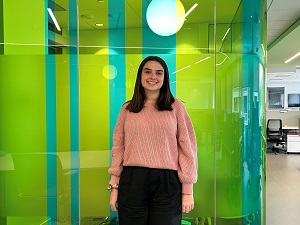
University and Program: Huron at Western, Psychology and Disability Studies
Supervisor: Dr Laura McAdam
Project Title: Evaluation of the Solution Focused Coaching-Peds (SFC-Peds) Strategy for Youth with Neuromuscular Conditions
Principal Investigator: Dr. Laura McAdam
Research Summary:
Background/Rationale: Goal setting is a key part of adolescence, facilitating self-determination and self-efficacy; however, youth with neuromuscular (NM) conditions have fewer goal setting opportunities. SFC-peds collaboratively promotes a youth’s ability to develop goals and plans specific to their needs and environments and is an effective goal setting strategy in healthcare.
Research Question: Is a single session or intensive (five session) SFC-peds intervention more effective in facilitating the creation and attainment of personally meaningful goals for youth with NM conditions? What are participants’ perceptions of the coaching experience and can it be applied in a clinical setting?
Methods & Analyses: Fourteen youth with NM conditions, aged 11-16 years, participated in a single session or intensive coaching intervention. For both groups, goals were set using the Canadian Occupational Performance Measure and Goal Attainment Scale at baseline and re-evaluated after 16 weeks. Nonparametric tests were used to assess goal attainment and comparison between intervention groups. Youth and caregivers had the option to complete qualitative interviews, which were analyzed using inductive thematic analysis.
Results/What We Are Learning: Participants generated and achieved personally meaningful goals based on the performance dimension of the COPM in the single (W=-2.52, p=0.01) and intensive (W=-2.71, p=0.01) groups, with no statistical difference between groups (U=36.5, p=0.75). Most goals focused on socialization and independence. Youth expressed feeling personally successful generating the goals and indicated it would be beneficial in the clinic.
Conclusions/Next Steps: SFC-peds is a successful coaching strategy. As the intervention group had no impact on achievement, it can be personalized.
Relevance to Holland Bloorview Clients & Families: Part of Holland Bloorview’s mission is to create and deliver “outstanding personalized, interprofessional care; and maximize function through cutting-edge treatment.” This study provides a personalized approach to setting and achieving meaningful goals within and beyond a clinical context, as well as insight into topics youth want to focus on in clinic particularly, connection and independence.
Bio:
Kate is entering her fourth year at Huron University College, an affiliate of Western University. She is pursuing an Honours Specialization in Psychology and a Minor in Disability Studies. Kate is interested in the intersection of health care and the human experience, particularly in patient outcomes. She has spent the summer working with Dr. Laura McAdam, investigating a solution focused coaching intervention that works to increase patient-autonomy and improve patient outcomes for youth with neuromuscular diagnoses.
Kate loves working with children, particularly those with disabilities. Kate holds a special place in her heart for Holland Bloorview. She grew up taking swimming lessons in the pool, has been a volunteer with the therapeutic recreation team for the past 5 years, and worked at Bloorview as a screener during the pandemic. The time Kate’s has spent at Bloorview has inspired her to pursue a master’s in social work, she hopes to eventually work with children with disabilities to address the specific mental health concerns that accompany a disability.
Kate is incredibly thankful for the opportunities provided by Dr. McAdam and the Ward program and is excited to use the skills and experiences she has gained this summer in her future research and work.

University and Program: University of Guelph, Biomedical Engineering
Supervisor and Lab: Dr. Jan Andrysek, PROPEL
Project Title: Applying a Co-Creation Approach to Analyze the Viability of a Biofeedback Application for Gait Training in Lower-Limb Prosthetic Users
Principal Investigator: Jan Andrysek
Research Summary:
Background: Lower-limb prosthetic users (LLPUs) learning to wear their prostheses often encounter difficulties developing healthy walking patterns. Wearable biofeedback (BFB) systems have the potential to augment conventional physiotherapy to provide gait training outside of the clinical environment, and as part of activities of daily living. However, it is important to gain an understanding of how BFB systems can be best utilized in the (re)habilitation of children and youths with LLPUs.
Research Question: Can a biofeedback system address key gaps in the gait training process of lower-limb prosthetic users?
Methods: To ensure clinical relevance, the BFB system was developed using a co-creation approach and involved 15 participants comprised of Holland Bloorview clients, clinicians, and trainees. Data collection methods included semi-structured interviews, user testing, and written feedback. All data was analyzed to determine what features should be incorporated into the BFB system.
Results: Preliminary interactions with the participants revealed key findings on the relevance of a supplementary gait training tool. Clinicians expressed interest in a validation tool to accompany their observation of parameters such symmetry and knee alignment. They believe a gait training application would greatly benefit new LLPUs and those receiving new prostheses. Summarized gait data reports that BFB can provide were also seen as highly beneficial. In addition, user testing prompted the implementation of several useability improvements and bug fixes to the BFB system.
Next Steps: Implementation of suggestions made by participants to help improve user value from this application.
Relevance to Holland Bloorview Clients & Families: A biofeedback system can enhance the quality and accessibility of gait rehabilitation for LLPUs, enabling users to continue gait training outside of the clinic and provide clinicians with quantitative data for more informed client assessments.
Bio:
Katie is in her fourth year of Biomedical Engineering at the University of Guelph. She is a member of the PROPEL Lab, working under the supervision of Dr. Jan Andrysek as a WARD student. Katie is involved in a project focusing on gait analysis and she is contributing to the development of a mobile application aiming to assist the rehabilitation process of lower-limb prosthetic users.
Previous experiences in the medical device industry have fueled her enthusiasm to work on technology that allows people to live healthier and more productive lives. Katie especially enjoys working in early product development and research. At Holland Bloorview, she is very excited to contribute to a project that can help enable greater mobility for individuals.
During her undergrad, Katie has continued to enjoy playing hockey and volleyball through involvement in intramurals. In her final year at university, she has also loved the experience of raising and training a dog for National Service Dogs.
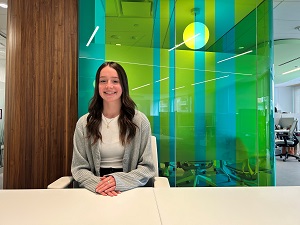
University and Program: Queen’s University - Applied Mathematics, Mechanics Option
Supervisor and Lab: Dr. Tom Chau, PRISM Lab
Project Title: Feasibility, signal processing, and feature extraction of mechanomyography (MMG) recordings during gait in a robotic walker for children with cerebral palsy.
Principal Investigator: Dr. Tom Chau
Research Summary:
Background/Rationale: Cerebral palsy (CP) is a childhood neuromotor disorder that affects movement capabilities. It is known that periods of walking or upright standing offers a multitude of health benefits. The Trexo robotic walker is a wearable exoskeleton that helps children with mobility barriers experience the feeling of upright over-ground walking. Analysis of muscle behavior during exoskeleton use is crucial for understanding the physical benefits of robotic gait training and value for clinical adoption.
Research Question: What is the feasibility of collecting MMG recordings in children with CP, and the muscular activation changes associated with exoskeleton powered physiotherapy?
Methods and Analysis: MMG recordings were collected using tri-axial accelerometers placed bilaterally on leg, glute, and trunk muscles of 5 participants with CP (aged 3-6; GMFCS IV). Data was collected pre- and post-exoskeleton intervention (6 weeks, twice weekly). Feasibility was evaluated based on set-up time, tolerance, and signal quality. The MMG signal processing pipeline is based on current literature.
Results: MMG sensor placement has been well tolerated. Readings were cleaned using a 4th order Butterworth bandpass filter and Bayesian denoising using a Symlet wavelet and soft thresholding. A MATLAB program was developed to extract amplitude and frequency variables.
Conclusions/Next Steps: The filtered and extracted MMG signals will be used to determine the onset of muscle fatigue, characterize muscle activations, and identify changes in movement quality.
Relevance to Holland Bloorview Families & Clients: Quantifying muscle behaviour during robotic gait training can help establish understanding and training limit thresholds to prevent overexertion during physiotherapy treatments, especially for nonverbal children.
Bio:
Keira Tanner is entering her third year at Queen’s University where she studies Applied Mathematics and Mechanical Engineering. Her goal is to combine her engineering education with her passion for health care and pediatrics. Keira’s ambition to contribute direct and meaningful impacts within biomedical engineering led her to the Ward Summer Student Program. This summer, she gained exposure to the field of pediatric disability research and invaluable knowledge from experienced students and researchers.
Keira has been working in the PRISM lab with PhD candidate Stefanie Bradley on her project with the Trexo Robotics walker. The study aims to investigate the neural, muscular, and functional gait changes following exoskeleton powered training in children with cerebral palsy. Keira is grateful to contribute to the future of this device and the opportunities it will bring for kids with mobility impairments.
Keira’s years of formal training in dance allow her to employ a creative process in every aspect of her life. Her understanding and appreciation for movement and physical activity is what drives her career goals in the fields of rehabilitation and prosthetics. In her free time, you can find her running, playing tennis, and enjoying time up north with her family and two dogs.
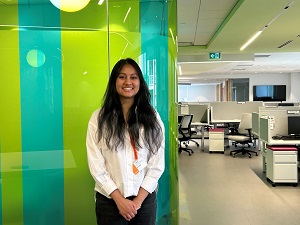
University and Program: Western University, Honours Specialization in Health Sciences, Minor in French Studies
Supervisors: Dr. Gillian King and Dr. Kate Einarson
Project Title: Optimizing the development, dissemination, and use of three psychosocial measures in pediatric rehabilitation using knowledge translation
Principal Investigator: Gillian King
Research Summary:
Background/Rationale: Effective dissemination of research requires knowledge translation (KT) planning (Barwick et al., 2014) informed by needs assessment (Graham et al., 2006). This KT project focused on three evidence-based measures developed by Dr. Gillian King to evaluate therapeutic engagement, clinical listening, and resiliency.
Research Question: How can KT theory and practice support the development, dissemination, and use of these three measures?
Methods: We conducted a needs assessment to identify the readiness of each measure. We employed KT strategies to support tool development (the RASC), tool dissemination (the PRIMEs), and tool use (the ELICS). We also identified best practices applicable across all products (e.g., accessible graphic design).
Results/What We Are Learning: Engagement, listening, and resiliency are interconnected aspects of pediatric rehabilitation. Although these three measures are related, each had different goals, and a variety of integrated KT and end-of-grant KT strategies were most appropriate to support their respective levels of maturity.
Conclusions and Next Steps: Interdisciplinary collaboration, needs assessments, and KT planning are necessary for research dissemination. We have obtained knowledge user feedback on several new KT products and are developing an evaluation scheme for acceptability, interest, and reach.
Relevance to Holland Bloorview Clients & Families: These evidence-based measures are designed to support optimal care for children with disabilities. Effective KT and dissemination support their reach and use, promoting effective listening skills, higher therapeutic engagement, and family-centred care.
References:
Barwick, Melanie & Phipps, David & Myers, Gary & Johnny, Michael & Coriandoli, Rossana.
(2014). Knowledge Translation and Strategic Communications: Unpacking Differences and Similarities for Scholarly and Research Communications. Scholarly and Research Communication. 5. https://doi.org/10.22230/src.2014v5n3a175
Graham, I. D., Logan, J., Harrison, M. B., Straus, S. E., Tetroe, J., Caswell, W., & Robinson, N.
(2006). Lost in knowledge translation: Time for a map? Journal of Continuing Education in the Health Professions, 26(1), 13–24. https://doi.org/10.1002/chp.47
2020 Guide to Producing Health Information for Children and Young People | Patient
Information Forum. (n.d.). 2020 guide to Producing Health Information for children and young people. Patient Information Forum. https://pifonline.org.uk/resources/publications/2020-guide-to-producing-health-information-for-children-and-young-people/
Bio:
Marlaine Ramoodith is a Health Sciences student at Western University. She is working alongside Dr. Gillian King and Dr. Kate Einarson on a multi-faceted project optimizing the mobilization of knowledge as it pertains to pediatric rehabilitation. In her work, she utilizes her unique skillset to combine clinical practice evaluation, therapeutic engagement strategies, graphic design, research and scientific inquiry, and knowledge translation. She is excited to collaborate with three external multidisciplinary health teams to support their research. Beyond her undergraduate degree, Marlaine plans to attend graduate school to obtain a Master of Public Health and become an Infectious Disease Epidemiologist.
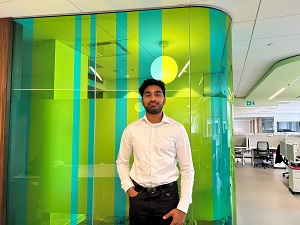
University and Program: Western University – Honours Double Major in Physiology and Interdisciplinary Medical Science
Supervisor and Lab: Dr. Tim Ross, EPIC Lab
Project Title: A Scoping Review of Promising Practices for Engaging Families in Childhood Disability Research
Principal Investigator: Dr. Tim Ross
Research Summary:
Background: In recent years family engagement has received a spike in attention among childhood disability researchers. Family engagement involves meaningfully including families and their perspectives in research processes to improve study designs and scopes, enhance analyses, and to produce useful knowledge mobilization products. Despite these research benefits and the increase in attention, relatively little is known about promising practices for engaging families in childhood disability research around the globe. Reviewing the literature on this topic can help us to understand useful policies and practices, and opportunities and challenges associated with meaningfully engaging families in research.
Research Question: What are promising practices for engaging families of children with disabilities in childhood disability research?
Methods: We conducted a scoping review that involved screening articles across six databases to identify articles intersecting family engagement and childhood disability. Two researchers are currently applying inclusion/exclusion criteria to 2585 records to identify the articles that will be included in this review.
Results: Articles will be summarized and analyzed to identify and discuss promising practices for family engagement in childhood disability research. Attention will also be given to identifying existing challenges and knowledge gaps associated with family engagement.
Conclusions: It is anticipated that findings will provide useful insights and practices that will help researchers to advance inclusive study designs that meaningfully account for the perspectives and experiences of families of children with disabilities.
Relevance to Holland Bloorview Clients & Families: Findings could help BRI researchers to advance study designs that are more inclusive to children with disabilities and their families. Findings could also help to inform family engagement practices on clinical matters. The final review will be provided to the BRI, its Research and Family Engagement Committee, and to Family Leaders for reference.
Bio:
Roshan has recently graduated with an Honours Bachelor of Medical Science majoring in Physiology and Interdisciplinary Medical Science from Western University. This summer, he has been working on a scoping review understanding the best practices for family engagement in childhood disability research. Although consulting with families of children with disabilities is becoming recognized as essential to the research process, there are still many barriers that hinder the process. Through analyzing the current literature in this field, he is determined to provide evidence-based recommendations towards effective family involvement. With the help of the EPIC Lab team, he has screened databases for relevant articles on this topic and is collaborating with family leaders to synthesize this information into a scoping review. He has learned how essential it is to value the input of those with lived experience in research to best serve the groups that have been marginalized by our current policies. His interest in this field has stemmed from his years of experience working with children with disabilities, starting with his time as a volunteer swim assistant at Holland Bloorview in 2017. Through working with Dr. Ross and the rest of the EPIC Lab, Roshan has developed an interest in addressing the social and institutional barriers and gaps that disable certain populations. The Ward program has provided him with unique experiences and perspectives on disability research that he will carry over into his future career.
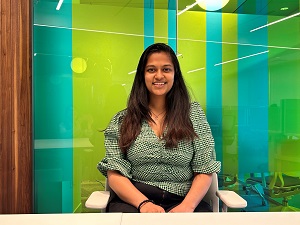
University and Program: University of Toronto - Electrical and Computer Engineering
Supervisor and Lab: Dr. Tom Chau - PRISM Lab
Project Title: Real-Time Denoising of EEG Signals in BCIs for Children with Disabilities
Principal Investigator: Dr. Tom Chau
Research Summary
Background: Brain-computer interfaces (BCIs) are systems that enable individuals to control external applications using their brain activity. Since BCIs circumvent the necessity for speech and motor control, they hold promise as an alternative means of access for children with disabilities. However, electroencephalography (EEG) signals can be corrupted by unwanted artifacts from various sources like eye blinks and muscle movements, hampering the effectiveness of BCIs. Hence, it is crucial to apply denoising methods to remove EEG artifacts in real-time.
Research Question: To what extent do online artifact removal algorithms impact the performance of EEG-based BCIs when utilized by children with disabilities?
Methods: Multiple machine learning algorithms were investigated for the online removal of EEG artifacts. We compared four neural network architectures from the EEGdenoiseNet reference paper, including a fully connected neural network, a simple convolution neural network, a complex convolution neural network, and a recurrent neural network. These models were trained to estimate artifact-free EEG signals from raw signals, using clean reference data manually denoised using independent component analysis. The model was evaluated on EEG data acquired during a visual P300 task using a consumer grade headset to simulate real-world applications.
Results: Preliminary analyses demonstrate that our machine learning model can remove eye-blink artifacts in contaminated EEG signals, while preserving the latency and amplitude of the P300 signal.
Conclusions: We validated a machine learning algorithm for the online removal of EEG artifacts for BCI applications. Future analysis will investigate the model’s performance on EEG data collected from children with disabilities and evaluate the model’s robustness to different artifact types.
Relevance to Holland Bloorview Clients & Families: By overcoming the problem of EEG artifacts produced by clients with uncontrolled movement, the artifact removal algorithm has the potential to improve the reliability and robustness of BCIs for children with disabilities.
Bio:
Shreya is a passionate and dedicated third-year computer engineer pursuing her studies at the University of Toronto. Originally from Kuwait, she possesses a deep appreciation for the power of technology to create meaningful impacts in society. From a young age, Shreya has been intrigued by technology and its boundless innovative opportunities.
Currently, Shreya is engaged in cutting-edge research under the guidance of Dr. Tom Chau in the PRISM Lab, where she is devoted to advancing brain-computer interfacing (BCI) technology. Her project focuses on developing innovative software techniques to detect and eliminate artifacts in electroencephalography (EEG) signals, aiming to enhance the usability and performance of BCIs for children with disabilities. By addressing these challenges, Shreya seeks to provide improved access to technology and empower children with disabilities to interact with the world through the power of their thoughts.
As a Ward Summer Student, Shreya feels fortunate to be part of a vibrant and collaborative community. One of the program's highlights is the opportunity to engage with her fellow colleagues, learn about their incredible research projects, and exchange ideas. This enriching environment allows her to learn from experts in the field and connect with other passionate students who share her drive for innovation. Through her work at Holland Bloorview and beyond, she hopes to make an impact in the field of medical technology. In her free time Shreya loves to travel, make resin art, and play with her dog Shiro.
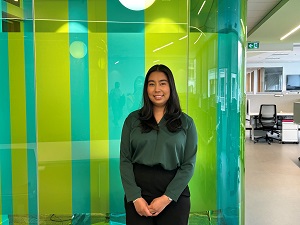
University and Program: Queen’s University, Honours Bachelor of Health Sciences
Supervisor and Lab: Dr. Sally Lindsay, TRAIL Lab
Project Title: Experiences of racial disparities and racism in health care for youth with autism spectrum disorder (ASD) and their caregivers: a systematic review
Principal Investigator: Dr. Sally Lindsay
Research Summary:
Background/Rationale: Despite the known health benefits of an early diagnosis and various therapeutic approaches for youth with autism spectrum disorder (ASD), racial disparities in ASD identification and care continue to persist. As such, it is important to learn from the experiences of those who live through racism to inform policies and interventions.
Research Question: What are the experiences of racism and racial disparities in health care among children and youth under 25 years of age with ASD and their caregivers?
Methods & Analyses: A systematic review was conducted drawing on six international databases. Following title and abstract screening and full-text review, 37 studies were included in the final analysis. A narrative synthesis utilizing an intersectionality framework was used to identify themes.
Results/What We Are Learning: Major disparities and unmet needs were identified for racial and ethnic minoritized youth with ASD in screening and referral, diagnosis, and therapeutic care. Barriers to accessing high-quality services included stereotypes and discrimination, family and community stigma, language barriers, and poor-quality health care interactions. Indirect barriers included travelling long distances to appointments and costs of care. An important facilitator was advocating for care. Recommendations by caregivers were to strengthen relationships between families and health care providers, increase education for families, and help families navigate health systems.
Conclusions/Next Steps: Several barriers exist for racialized minority youth with ASD and their caregivers to access high-quality care. More research is needed to explore youth’s perspectives and interventions to improve health equity.
Relevance to Holland Bloorview Clients & Families: Clinicians should listen to youth with ASD and their caregivers, and critically reflect on how the barriers they experience may impact their interactions with clients. More work is needed to collect race-based data to identify inequities and develop solutions for Bloorview clients and families.
Bio:
Simran is entering her fourth and final year of the Bachelor of Health Sciences (Honours) program at Queen’s University. Through her coursework and extra-curricular activities at Queen’s, she has developed a passion for inclusivity, equity work, and the importance of listening to the lived experiences of underrepresented populations. Having volunteered with Holland Bloorview for several years in various settings, she is also extremely interested in advancing care for children with disabilities. As such, the Ward Family Summer Student Research Program presents a unique opportunity to research the lived experiences of youth with disabilities and help improve health care for underrepresented populations.
Working with the TRAIL Lab this summer under supervision by Dr. Sally Lindsay, Simran has been able to conduct a systematic review on the experiences of racism and racial disparities in health care among children and youth with autism spectrum disorder and their caregivers. She aims to continue advancing health equity in her career as a health professional and is thankful for the opportunity to work with and learn from an interdisciplinary team of researchers. Outside of her school and work, Simran loves to play tennis, try out new recipes, and spend time with her family including her dog, Toby.
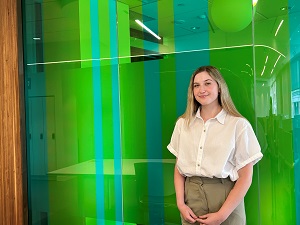
University and Program: McGill University, Neuroscience
Supervisor and Lab: Dr. Danielle Baribeau, Autism Research Centre
Project Title: Clinical characteristics of children with neurodevelopmental disorders and co-occurring epilepsy
Principal Investigator: Dr. Danielle Baribeau
Research Summary:
Background: Research shows that youth with neurodevelopmental disorders (NDDs) have a significantly increased risk of experiencing a mental health crisis. Meta-analyses have also shown that approximately 7% of youth with NDDs have epilepsy, a condition characterized by reoccurring, unprovoked seizures. Both the clinical presentation and pharmacological treatment of epilepsy can impact the presentation and treatment of co-occurring mental health conditions in youth with NDDs.
Research Question: How does co-occurring epilepsy impact incidence of behavioural crises and psychotropic polypharmacy in children and youth with NDDs?
Methods & Analyses: We conducted a chart review to collect longitudinal demographic, clinical, and environmental data from Holland Bloorview’s psychopharmacology clinic. We performed preliminary analyses to examine the prevalence of co-occurring epilepsy, incidence of behavioural crisis and psychotropic polypharmacy in those with epilepsy, and how co-occurring epilepsy impacts the incidence of behavioural crises over time using a cox proportional hazard model.
Results: Charts from a total of 88 psychopharmacology clinic patients were reviewed. Preliminary analyses showed that 20.5% of patients had a diagnosis of epilepsy. The proportion of patients being prescribed 2 or more psychotropic medications was lower in those with epilepsy (χ2 = 6.2, p = 0.01). Finally, the cox proportional hazards model showed that co-occurring epilepsy may be associated with fewer behavioural crises (Hazard ratio = 0.37 (0.13 to 1.04), p = 0.058).
Conclusions: These analyses indicate that a diagnosis of epilepsy in youth with NDDs may have an impact on mental health treatments and outcomes and therefore must be considered in future research on the intersection of NDDs and psychiatric conditions. Next steps include expanding the sample to a total of 377 patients and conducting multivariate analyses.
Relevance to Holland Bloorview Clients & Families: Understanding the ways in which co-occurring NDDs and epilepsy impact mental health treatments and outcomes will help us to implement personalized and preventative treatment approaches for this population at Holland Bloorview.
Bio:
Sophia Lenz just completed her undergraduate degree in neuroscience at McGill University and she is delighted to be a part of the Ward Family Summer Student Research Program.
Working under Dr. Danielle Baribeau (MD, PhD), Sophia is conducting a chart review of patients from Holland Bloorview’s psychopharmacology clinic to better understand the intersection of neurodevelopmental disorders, such as autism spectrum disorder, and mental health outcomes. Particularly, she is investigating possible predictors of mental health crises in autistic kids and youth, which, in the future, can hopefully help us to implement preventative measures to protect those who are more vulnerable to crisis.
Sophia has had a longstanding passion for working with the disabled community. Having grown up with a disabled sister who received care through Holland Bloorview, and through volunteering at Park Lane Public School and Holland Bloorview, Sophia has gained unique insight into the needs of disabled kids and youth and their families. She is excited to now tie this passion into her academic work. Sophia hopes to gain insight into how we can help to achieve justice for the disabled community through research.
In her free time, Sophia is a climate justice organizer that works on fossil fuel divestment campaigns. She also loves baking, singing and playing the guitar, and matcha lattes.

University and Program: Western University, Honors Specialization (Bsc) in Psychology
Supervisor and Lab: Dr. Shannon Scratch, NOvEL Lab
Project Title: An Exploratory Analysis of Youth with Concussion using the Persistent Concussion, Anxiety, Neuropsychology and Neuroimaging (PeCANN) Pilot Project
Principal Investigator: Shannon Scratch
Research Summary:
Background/Rationale: While most youth recover quickly from concussion, approximately 30% experience chronic symptoms, meeting the criteria for persistent post-concussion symptoms (PPCS). PPCS impacts somatic, cognitive, and psychological domains, of which mental health symptoms are frequently observed.
Currently, clinicians depend on self-report and clinical history for decision-making; however, neuroimaging combined with neuropsychology could improve diagnostic parameters. Specifically, functional magnetic resonance imaging (fMRI) may identify regional and/or network connectivity. Prior investigations from the NOvEL lab showed alterations of frontoparietal network-amygdala (FPN-A) connectivity within concussed youth; however, this has not been explored in youth with persistent symptoms.
Research Question: Using a sub-group exploratory analysis, we aimed to investigate: (1) mean differences between youth with PPCS and normative samples on neuropsychology assessment, and (2) brain-behaviour relationships of youth with PPCS using resting-state fMRI and neuropsychology assessment.
Methods and Analyses: Youth with PPCS (12-18 years old, n=16) participated in the PeCANN study (Bloorview Research Institute), comprised of neuropsychology assessment (cognitive battery, behavioural/emotional self-report questionnaires) and MRI.
One sample T- tests compared task performance and questionnaire scores between PPCS sub-group and normative samples. Multiple linear regressions investigated whether FPN-A correlation and/or global FPN connectivity predicted cognitive performance and/or emotional/behavioural profiles.
Results: Compared to normative samples, significant differences were found on measures of memory, self-prescribed perfectionistic behaviours, anxiety-related symptoms and internalizing problems. Linear regressions revealed global FPN connectivity significantly predicted performance on trial A5 of a working memory task (ß= -3.7043, p<0.05).
Next Steps & Relevance to HB Families: Recruited from the Persistent Concussion Clinic, participant results directly reflect challenges faced by this population. PPCS youth scored significantly higher on measures of internalizing problems, anxiety, and perfectionistic behaviours, emphasizing mental health challenges in this group. While only sub-group was analyzed, PeCANN includes an anxiety control group, which will highlight similarities and distinctions. Additionally, the significant finding of global FPN connectivity and memory warrants further investigation of brain-behaviour relationships in PPCS populations.
Bio:
Staci is entering on her fourth year at the University of Western Ontario, pursuing an Honors Bachelor of Science in Psychology. As a member within the NOvEL Lab, she has the privilege of collaborating with PhD student Elena Sheldrake on the PeCANN project where they will be investigating the neuropsychological and neuroimaging outcomes for youth experiencing post-concussive symptoms. She looks forward to exploring the results derived and learning how they can be applied within a clinical setting.
Staci has always been passionate about working with children with disabilities; this has been fostered by her experiences at Holland Bloorview, both as a former patient and volunteer. The Ward Program presents a wonderful opportunity for her to combine her admiration for the institution with her research interests. She has always admired the Holland Bloorview staff and their impactful work and is thrilled to contribute to a place that means so much to her.
Upon completing her undergraduate degree, Staci plans on pursuing graduate studies within Clinical Developmental Psychology as she aspires to work with children and their families. In her free time, Staci enjoys listening to music (particularly Taylor swift), playing guitar, piano, reading, and going on walks with her dog Daisy.
University and Program: Queens University, Honours Bachelor of Health Sciences
Supervisor and Lab: Dr. Darcy Fehlings, CP Discovery Lab
Project Title: Developing a scoring aid for the Hammersmith Infant Neurological Exam (HINE) to facilitate early detection of cerebral palsy in high-risk infants
Principal Investigator: Dr. Darcy Fehlings
Research Summary:
Background/Rationale: In Canada, children are currently diagnosed with cerebral palsy (CP) at 18.9 months, which is later than the international clinical practice guideline recommended age of <12 months [1]. Early detection of CP is essential to receive early interventions to optimize motor and cognitive plasticity [2]. The Hammersmith Infant Neurological Exam (HINE) is a standardized assessment used with high-risk infants (i.e., those who have been in the neonatal intensive care unit) to identify infants with a high probability of CP. HINE scores require interpretation that varies according to age, which could be a barrier to integrating the HINE since the tool is new to Canadian clinics.
Research Objective: To develop an evidence-based HINE Scoring Aid to help clinicians interpret HINE scores and suggest potential next steps, including early intervention referrals.
Methods & Analyses: After a literature search, HINE scoring information was amalgamated into a one-page HINE Scoring Aid which was shared with Canadian clinicians in 12 clinics via Canadian Neonatal Follow-Up Network to assess clinical uptake and collect feedback.
Results/What are we learning: Approximately 85% of Canadian clinics (10 of 12 clinics) have integrated the HINE into their clinical practice. Of those, 90% (9 clinics) are using the HINE Scoring Aid. Positive and developmental feedback from occupational therapists, developmental pediatricians and clinical neonatologists across Canada continues to be received.
Conclusion/Next Steps: We continue to learn about facilitators for integration of the aid into Canadian clinical practice. Next steps include publishing the HINE Scoring Aid to increase clinical uptake internationally.
Relevance to HB clients and families: The HINE Scoring Aid aims to promote clinical use of the HINE and thereby facilitate early detection of CP and early intervention referrals, resulting in earlier treatments available for children with CP at Holland Bloorview and beyond.
References:
[1] Novak, I., Morgan, C., Adde, L., Blackman, J., Boyd, R. N., Brunstrom-Hernandez, J., ... & Badawi, N. (2017). Early, accurate diagnosis and early intervention in cerebral palsy: advances in diagnosis and treatment. JAMA pediatrics, 171(9), 897-907.
[2] Morgan C, Fetters L, Adde L, et al. Early Intervention for Children Aged 0 to 2 Years With or at High Risk of Cerebral Palsy: International Clinical Practice Guideline Based on Systematic Reviews. JAMA Pediatr. 2021;175(8):846–858. doi:10.1001/jamapediatrics.2021.0878
Bio:
Swetlana Kumar is going into her second year of a Bachelor of Health Sciences degree at Queen’s University. She is working in the CP Discovery Lab this summer with Dr. Darcy Fehlings. She has an avid interest in healthcare and understanding barriers and facilitators that can affect it. Some of her favourite parts of the program so far have been the recent Wheelchair Basketball event and getting to know the rest of the Ward summer students.
Swetlana spent her first year at Queen’s University at Herstmonceux Castle in the United Kingdom as part of Bader College. Through experiences such as visiting the Florence Nightingale Museum and the Roman Baths in Bath, as well as attending talks from international guest speakers, she had the opportunity to gain a truly interdisciplinary and global perspective on healthcare and research.
After looking at different summer opportunities, Swetlana decided to apply to the Ward program because it offered something that not many others did. The Ward program offered her a summer job, but it also offered an unrivaled academic experience. The combination of Lunch ‘n Learns led by experts in their fields, the opportunity to present at the Ward Summer Student Research Day, and exposure to the vast field of childhood disability research made the program one that not only teaches but enriches. Swetlana is currently working on the national EDIT-CP project in the CP Discovery Lab.
University and Program: York University, Osgoode Hall Law School
Supervisor and Lab: Dr. Evdokia Anagnostou, Autism Research Centre
Project Title: The Path of Good Medicine: Towards Health Equity for First Nations Children
Principal Investigator: Aleshia Johnson
Background/Rationale: Across Canada, First Nations children with neurodevelopmental disabilities experience disparate health outcomes as compared to non-aboriginal children. The unresolved historical legacies of residential schools, the 60’s Scoop, as well as contemporary child welfare policies and practices (the “Millennium Scoop”) exacerbate the disappointment and distrust widely felt among First Nations towards settler institutions authorized to provide essential services to the public. At the present moment, the Canadian health care systems struggle to fulsomely address and remedy the many structural barriers which thwart the provision of timely access to health services. These barriers converge at the intersection of culture, disability, and politics which ultimately construct the range of inequities, inequalities, and injustices experienced by First Nations children with disabilities.
Research Objective: By way of critical race and disability theoretical frameworks, I analyze the intersection between First Nations children and neurodevelopmental disabilities, including prevalence rates, disparate outcomes and structural barriers within the health care system. I advocate for the development of culturally-informed clinical and research practices that promote First Nations autonomy, health equity, and timely access to health justice.
First, I discuss recent studies and academic discourse centered on the unique challenges and disparities experienced by First Nations children within the Canadian health care system, including the issues of underrepresentation (and over-representation), under-diagnosis, as well as the limitations imposed by culturally hegemonic approaches to both health data collection and dissemination.
Next, I review the cases of Jordan River Anderson (2006) and Jeremy Beadle (2015) in order to highlight two landmark cases which illustrate how funding disputes between federal and provincial governments continue to delay and frustrate the seamless provision of essential health care services to First Nations children with neurodevelopmental disabilities.
I then deconstruct the normative concept of disability and reconstruct the paradigm with an appeal to First Nations health, wellness, and child-rearing traditions. Specifically, I consider how particular Indigenous cultures acknowledge and understand neurodiversity with reference to the First Nations of Canada (North), the Navajo of the American South-West (South-West), and the Maori of the Pacific (East). I advocate for the full inclusion of First Nations, Inuit and Métis governments, organizations, and service providers as primary agents in decision-making, research, and data sharing within the context of Canadian health care system, especially as regards the interests of First Nations children. Such an initiative holds significant promise to rectify historical injustices, ameliorate quality of life, and transform the status quo into an equitable expression of health justice. Moreover, this call to action promotes Indigenous self-determination and engages the principles articulated under s.35(1) of the Charter of Rights and Freedoms in addition to international human rights standards defined under the United Nations Declaration on the Rights of Indigenous Peoples and the Convention on the Rights of Disabled Children.
Methods & Analyses: Full-scale review of academic literature, media, and other publications related to the keywords, “First Nations children,” “neurodevelopmental disorders,” “autism,” “Jordan’s Principle”, and “culture-bound syndromes.” Collected data entered into chart in chronological order to assess the history and progression of health care justice issues emerging from these concepts. In collaboration with supervisors, synthesize data and draft publication detailing findings and propose recommendations for improved First Nations health care policy.
Results/What are we learning:
• First Nations children are among the most vulnerable populations in Canada.
• First Nations children are over-represented in the child welfare system.
• First Nations children are under-represented in health data, particularly neurodevelopmental disability research.
• The statistical disparities and poor life outcomes connect directly with the socioeconomic impact of colonization as well as the historical legacy of residential schools, the 60’s scoop, and contemporary child welfare systems.
• First Nations express unique perspectives regarding children, health, wellness, disability, and neurodiversity.
• Some cultural expressions and values conflict with Western institutional policies and procedure.
• The full inclusion of First Nations governments, organizations, and service providers within Canada’s health care research and delivery system involves the empowerment of stakeholders to exercise self-determination and to implement cultural perspectives, traditions, and values into the current health care system infrastructure.
• Such an initiative holds significant promise to rectify historical injustices, improve the welfare of present and future First Nations children, and to endorse reconciliation between Indigenous and settler governments and institutions.
Conclusion/Next Steps:
1. Research review and synthesis.
2. Draft independent research paper.
3. Peer-editing.
4. Publication.
Relevance:
Since 2015, the Truth and Reconciliation Commission’s 94 Calls to Action have called upon governments and all levels of society, including health, legal and research institutions, to join with First Nations around Canada in collectively building pathways of healing, reconciliation, and justice. Calls No. 18 — 24 describe the Commission’s exhortation to federal, provincial, and territorial governments to acknowledge the direct correlation between disparate Aboriginal health outcomes and the legacy of destructive government policies, including residential schools. The section further urges all levels of government to recognize and protect Aboriginal health-care rights as established by constitutional and international law, as well as historical treaties.
Recently, the Holland Bloorview Research Institute established the Indigenous Research Summer Program as an additional focus area within the Ward Family Summer Student Research Program which created two additional streams to promote the full inclusion and participation of Indigenous students in paediatric research. This initiative aims to increase equal and equitable access to professional and mentorship opportunities for Indigenous students who contribute distinct skills, cultural knowledge, experiences, and perspectives. Moreover, the Indigenous Research Summer Program provides the foundation upon which to cultivate and disseminate culturally-informed research that promotes the objectives established in the TRC Calls to Action.
Bio:
Aleshia Johnson (she/her) is a recent law school graduate of Osgoode Hall Law School, York University (2023) and community advocate based in Hamilton, Ontario. She is First Nations (Mohawk – Six Nations of the Grand River) and Black (Bahamas) which enables her to approach her legal and social research from an intersectional, cultural, and trauma-informed perspective. This summer, Aleshia will begin her law articles at a corporate law firm which specializes in the Aboriginal business law practice area. In her spare time, Aleshia enjoys playing piano, and practicing spirituality and meditation as part of her wellness routine.
